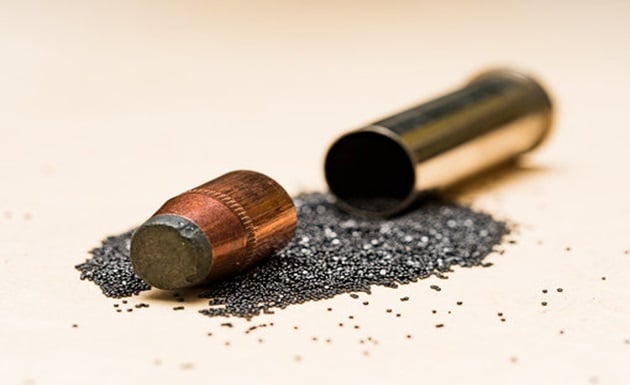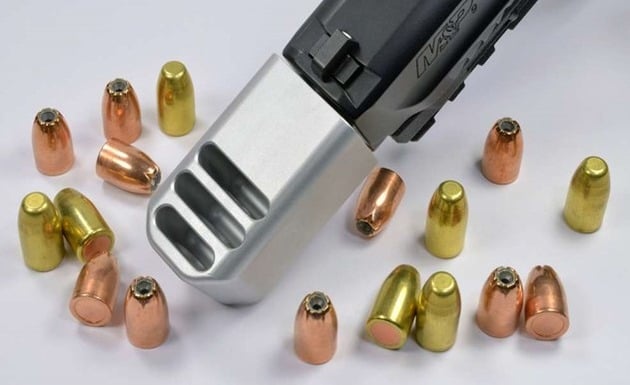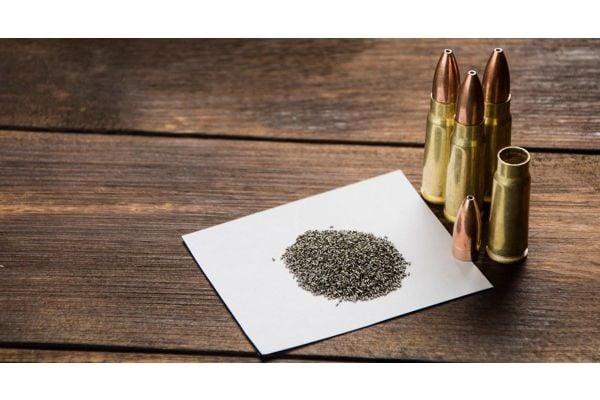All ammunition, whether it's for a rifle, shotgun, pistol, or revolver, has the same basic parts.
These components include
- The Case
- Powder
- The Primer
- The Projectile
The projectile is typically a bullet but can also be a variety of shot or slugs in the case of a shotgun.
All of these parts work in tandem to send the projectile out of the barrel of your firearm.
Read on to find out more about the basic parts of ammunition
The Case
The case of your ammunition is what holds all of the other components together.
Cases are typically made of brass but can also be made of steel or aluminum.
For semi-automatic weapons, the case is ejected from the gun as it is fired. Think about an action movie — the casings are what's flying around during a heated firefight, and spent brass casings can usually be observed falling across the floor.




With revolvers, the spent casings remain in the individual chambers in the cylinder until they are manually removed.
Shotgun shells use a different type of case — they're typically made of plastic with a small amount of metal on the bottom that includes the primer.
Shotgun ammo size is usually classified by gauge, such as 12 gauge or 20 gauge.
The Primer
The primer is what sets things in motion after you pull the trigger.
With Centerfire ammunition (which includes most types of ammo), when the firing pin strikes the primer cap it crushes the priming compound against the anvil, causing the priming compound to explode.
While not a big explosion, it's enough to generate a small flame that travels through the flash hole and ignites the gunpowder inside the case.
The gunpowder is quickly converted into an expanding gas that sends the projectile out of the barrel.




Centerfire ammunition has a primer that is manufactured separately and then inserted into the base of the cartridge during the manufacturing process.
Rimfire ammunition, on the other hand, has a specially formulated priming compound -- sometimes mixed with sand or glass.
Rimfire ammo has a hollow rim on the base of the cartridge that has priming compound spun into it before the cartridge is loaded.
Rimfire ammo is then fired by a firing pin crushing the rim of the cartridge to ignite the priming compound and then the powder.
Gunpowder or Propellant
Gunpowder is the typical generic term people use when talking about the propellant of a cartridge.
Many years ago, black powder was used for ammunition, but nowadays, reloaders and manufacturers use smokeless powder instead.
If you've seen movies about the Revolutionary War or the Old West, you may recall seeing lots of smoke and what looks like fog on the battlefield following a particularly intense fight.




This was caused by black powder — when it burns, it creates a lot of smoke.
Real black powder is also far more dangerous than the modern smokeless powders that are used today.
The amount of powder included in the case depends on the caliber and load.
When your gunpowder or propellant burns, it forces the bullet free from the case, sending it down the length of the barrel.
The Projectile / Bullet
The last component of ammunition is the projectile.
The type of projectile required depends on the type of gun you're firing. If you're using a centerfire rifle or handgun, the projectile is usually a bullet.
If you're firing a shotgun, the projectile could be buckshot, birdshot, or any number of other exotic projectiles. Some people mistakenly call the entire cartridge a "bullet", but this isn't accurate.
The term “Bullet” refers to the projectile portion of the cartridge— it's what flies out of the barrel when the gun is fired.




There are a vast number of bullet designs, and they all have specific applications.
For example, full metal jacket (FMJ) bullets are fairly cheap and as a result are good options for target practice.
Bullets designed for self-defense or hunting, on the other hand, typically expand on impact to create devastating internal damage.
In addition to different shapes or designs, bullets are also made from a variety of materials.
Most are made primarily of lead alloys with a copper jacket (coating) on the outside. Some higher-end bullets are made of a solid chunk of copper which can provide an environmentally-friendly shooting experience.
Others materials may include steel, tungsten, or even depleted uranium!
Bonus: Shotgun Shells
While bullets are used in rifles, pistols, and revolvers, shotgun ammo includes many more options.
Though there are many types of shotgun ammo, they all include a piece called “wadding” or “wad,” which separates the powder from the shot and or slug.
It also helps force the shot or slug out of the barrel. Historically the wad was made of materials like paper, felt or cork, but now they are 100% plastic.
Birdshot generally looks like tiny balls made of steel or lead. Hunters may use it to shoot birds, small game, or sporting clays.
When it's fired, birdshot will spread out into a group, pattern, or cluster, which is why it's used for fast-moving targets.




Buckshot is composed of slightly larger balls made of the same materials.
There are fewer of them per shotgun shell, so they still scatter, but not as much. Hunters typically use them to hunt deer or other small game, but they are also commonly used for self-defense.
Slugs look similar to bullets in that they're made of one solid piece of metal (usually steel or lead).
They're shaped to be aerodynamic, and they're generally considered to be the most powerful type of ammunition for shotguns.

